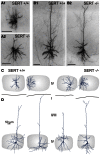High serotonin levels during brain development alter the structural input-output connectivity of neural networks in the rat somatosensory layer IV
- PMID: 23761736
- PMCID: PMC3675331
- DOI: 10.3389/fncel.2013.00088
High serotonin levels during brain development alter the structural input-output connectivity of neural networks in the rat somatosensory layer IV
Abstract
Homeostatic regulation of serotonin (5-HT) concentration is critical for "normal" topographical organization and development of thalamocortical (TC) afferent circuits. Down-regulation of the serotonin transporter (SERT) and the consequent impaired reuptake of 5-HT at the synapse, results in a reduced terminal branching of developing TC afferents within the primary somatosensory cortex (S1). Despite the presence of multiple genetic models, the effect of high extracellular 5-HT levels on the structure and function of developing intracortical neural networks is far from being understood. Here, using juvenile SERT knockout (SERT(-/-)) rats we investigated, in vitro, the effect of increased 5-HT levels on the structural organization of (i) the TC projections of the ventroposteromedial thalamic nucleus toward S1, (ii) the general barrel-field pattern, and (iii) the electrophysiological and morphological properties of the excitatory cell population in layer IV of S1 [spiny stellate (SpSt) and pyramidal cells]. Our results confirmed previous findings that high levels of 5-HT during development lead to a reduction of the topographical precision of TCA projections toward the barrel cortex. Also, the barrel pattern was altered but not abolished in SERT(-/-) rats. In layer IV, both excitatory SpSt and pyramidal cells showed a significantly reduced intracolumnar organization of their axonal projections. In addition, the layer IV SpSt cells gave rise to a prominent projection toward the infragranular layer Vb. Our findings point to a structural and functional reorganization of TCAs, as well as early stage intracortical microcircuitry, following the disruption of 5-HT reuptake during critical developmental periods. The increased projection pattern of the layer IV neurons suggests that the intracortical network changes are not limited to the main entry layer IV but may also affect the subsequent stages of the canonical circuits of the barrel cortex.
Keywords: SERT; barrel cortex; columnar circuitry; morphology; pyramidal cell; serotonin; somatosensory; spiny stellate cell.
Figures






Similar articles
-
Reduced Inhibition within Layer IV of Sert Knockout Rat Barrel Cortex is Associated with Faster Sensory Integration.Cereb Cortex. 2017 Feb 1;27(2):933-949. doi: 10.1093/cercor/bhx016. Cereb Cortex. 2017. PMID: 28158484 Free PMC article.
-
Intracortical connectivity of layer VI pyramidal neurons in the somatosensory cortex of normal and barrelless mice.Eur J Neurosci. 2012 Mar;35(6):855-69. doi: 10.1111/j.1460-9568.2012.08011.x. Epub 2012 Feb 22. Eur J Neurosci. 2012. PMID: 22356566
-
Effects of alterations of the vibrissae-related organization of thalamocortical axons upon the organization and outgrowth of intracortical connections in the barrelfield of the rat.Somatosens Mot Res. 2002;19(2):125-9. doi: 10.1080/08990220220131515. Somatosens Mot Res. 2002. PMID: 12088386
-
Mapping functional connectivity in barrel-related columns reveals layer- and cell type-specific microcircuits.Brain Struct Funct. 2007 Sep;212(2):107-19. doi: 10.1007/s00429-007-0147-z. Epub 2007 Jun 26. Brain Struct Funct. 2007. PMID: 17717691 Review.
-
Thalamocortical control of feed-forward inhibition in awake somatosensory 'barrel' cortex.Philos Trans R Soc Lond B Biol Sci. 2002 Dec 29;357(1428):1717-27. doi: 10.1098/rstb.2002.1156. Philos Trans R Soc Lond B Biol Sci. 2002. PMID: 12626006 Free PMC article. Review.
Cited by
-
Endocannabinoid-dependent formation of columnar axonal projection in the mouse cerebral cortex.Proc Natl Acad Sci U S A. 2022 Sep 13;119(37):e2122700119. doi: 10.1073/pnas.2122700119. Epub 2022 Sep 6. Proc Natl Acad Sci U S A. 2022. PMID: 36067295 Free PMC article.
-
Reduced Inhibition within Layer IV of Sert Knockout Rat Barrel Cortex is Associated with Faster Sensory Integration.Cereb Cortex. 2017 Feb 1;27(2):933-949. doi: 10.1093/cercor/bhx016. Cereb Cortex. 2017. PMID: 28158484 Free PMC article.
-
Genetic Knockout of the Serotonin Reuptake Transporter Results in the Reduction of Dendritic Spines in In vitro Rat Cortical Neuronal Culture.J Mol Neurosci. 2021 Nov;71(11):2210-2218. doi: 10.1007/s12031-020-01764-9. Epub 2021 Jan 5. J Mol Neurosci. 2021. PMID: 33403594
-
The chemokine Cxcl14 regulates interneuron differentiation in layer I of the somatosensory cortex.Cell Rep. 2024 Aug 27;43(8):114531. doi: 10.1016/j.celrep.2024.114531. Epub 2024 Jul 25. Cell Rep. 2024. PMID: 39058591 Free PMC article.
-
Association between maternal antidepressant use during pregnancy and the risk of autism spectrum disorder and attention deficit hyperactivity disorder in offspring.Eur Child Adolesc Psychiatry. 2024 Dec;33(12):4273-4283. doi: 10.1007/s00787-024-02460-4. Epub 2024 May 19. Eur Child Adolesc Psychiatry. 2024. PMID: 38762849
References
LinkOut - more resources
Full Text Sources
Other Literature Sources

